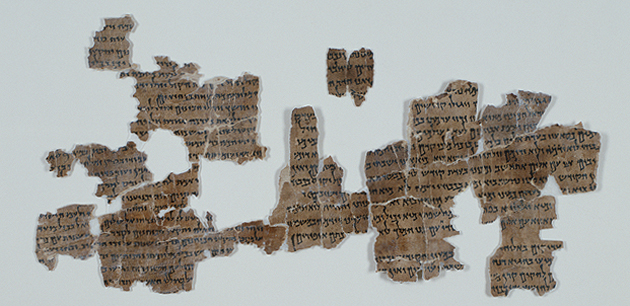A Fragmented History
New York City's Dead Sea Scroll exhibit is curated by SDSU professor Risa Levitt Kohn.

Tattered and decaying pieces of parchment would seem to be ancient history, but the 2,000-year-old Dead Sea Scrolls that were discovered over 60 years ago in 11 caves at present day West Bank, continue to be a hot topic that elicit much debate.
The most comprehensive collection of ancient biblical artifacts ever displayed outside of Israel, made their world debut at Discovery Times Square in Manhattan on Oct. 28. The exhibit, curated by San Diego State University professor Risa Levitt Kohn, includes 20 sea scrolls — four of which have never been made public.
Surviving millennia
“How do you begin to understand what happened 2,000 to 3,000 years ago?” said Levitt Kohn, who teaches about the Hebrew Bible and Judaism in SDSU’s Department of Religious Studies. “By looking at what survived.”
In 2007, Levitt Kohn curated the Dead Sea Scrolls exhibit at the San Diego Natural History Museum. Since then, she has traveled the country with the scrolls, curating four exhibitions.
“The New York show is unlike the others because it incorporates a biblical component. It allows visitors to learn about the scrolls in the context of the biblical period,” said Levitt Kohn.
Recreating history
The exhibit, titled “Dead Sea Scrolls: Life and Faith in Biblical Times,” uses 500 ancient artifacts from the biblical period through the Byzantine period in Israel including a three-ton stone from Jerusalem’s Western Wall. Visitors are given a 360-degree sensory experience of Israel, including the sights and sounds of the Dead Sea’s waves ebbing and flowing, and a live feed from the Western Wall.
“How do you begin to understand what happened 2,000 to 3,000 years ago? By looking at what survived.”
The show’s centerpiece is an exhibit of scrolls from the biblical books of Genesis, Psalms, Exodus and Isaiah in a rotunda. While 20 sea scrolls will be displayed throughout the six-month exhibition, only 10 will be viewed at a time. The scrolls will be rotated and replaced by 10 different scrolls after 90 days due to their sensitivity to light, and to ensure the health and longevity of the materials. The biblical scrolls are the oldest copies of the Hebrew Bible discovered to date.
Expanding Levitt Kohn's curriculum
Levitt Kohn, who took a two-year sabbatical from SDSU to work with the Israel Antiquities Authority for the exhibit, said that her research has enhanced the learning experience for students in her classes. Through her research, she has been able to bring the discoveries of the Dead Sea to life in her classroom.
“Curating the exhibit has been such a natural extension of teaching. In fact, it has improved my teaching and expanded my curriculum. What you see in the exhibit is what I teach in the classroom,” Levitt Kohn said.
Beginning Dec. 16 through Jan. 2, the exhibit will feature a rare opportunity to view the Ten Commandments. The scroll, which was written between 50 BCE and 1 BCE, is the oldest known parchment of the Ten Commandments. It is also the most complete and well-preserved text of the Ten Commandments in existence.
The exhibit will be on display through April 2012 at Discovery Times Square, and will travel to Philadelphia’s Franklin Institute for a five-month run beginning May 2012.



